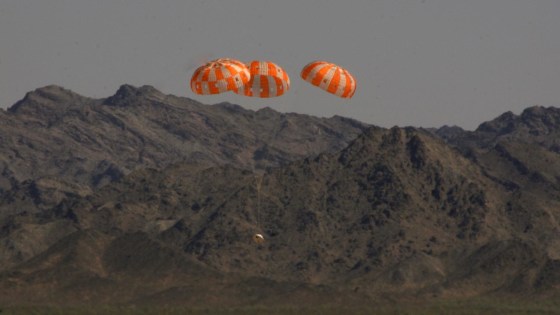NASA says the parachute designed for its Orion interplanetary spaceship passed its most complex test to date on Wednesday — but an even bigger test is still to come.
At the start of Wednesday's run-through, a test version of the Orion craft was pulled out of a C-17 aircraft, 35,000 feet above the U.S Army's Yuma Proving Ground in Arizona. The craft went into a 10-second free fall, and then the parachute system was triggered to slow its descent. Engineers rigged the system with a built-in malfunction to see if it could tolerate failure. It could. The Orion test craft touched down safely in the desert, NASA reported.
Sign up for Science news delivered to your inbox
The big test comes in December. That's when an uncrewed Orion spaceship will be launched atop a Delta 4 Heavy rocket, soar as far as 3,600 miles (5,800 kilometers) into space during a four-orbit journey, and then come screaming back to Earth at a speed of almost 20,000 mph (32,000 kilometers per hour).
The Orion's heat shield will have to weather temperatures near 4,000 degrees Fahrenheit (2,200 degrees Celsius). At the proper time, two drogue chutes and three main parachutes will have to pop out to slow down the Orion's fall to a manageable 20 mph for a Pacific Ocean splashdown.
That trial is called Exploration Flight Test 1, or EFT-1, and it's meant to blaze a trail for an uncrewed round-the-moon flight test that pairs Orion with NASA's heavy-lift Space Launch System in 2017. The first crewed Orion-SLS flight could come as early as 2021. NASA plans to use the spacecraft to send astronauts to a near-Earth asteroid, and then to Mars and its moons in the 2030s.
